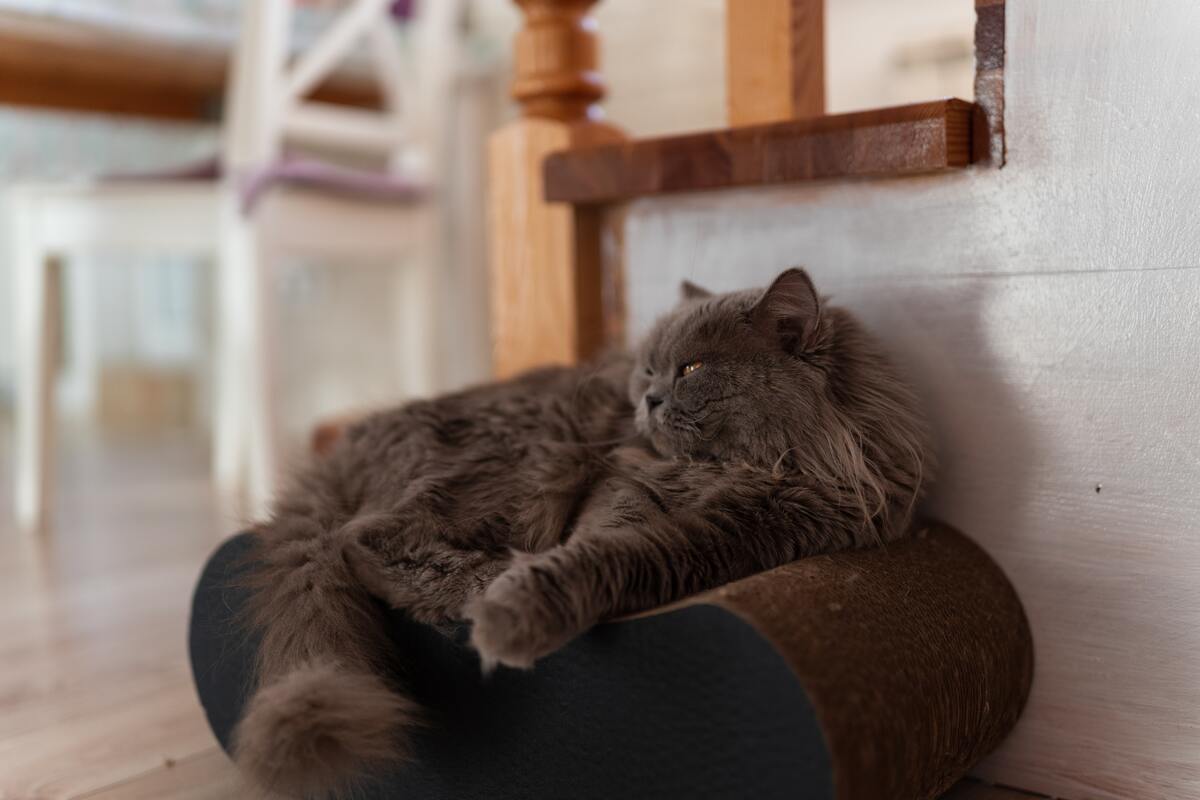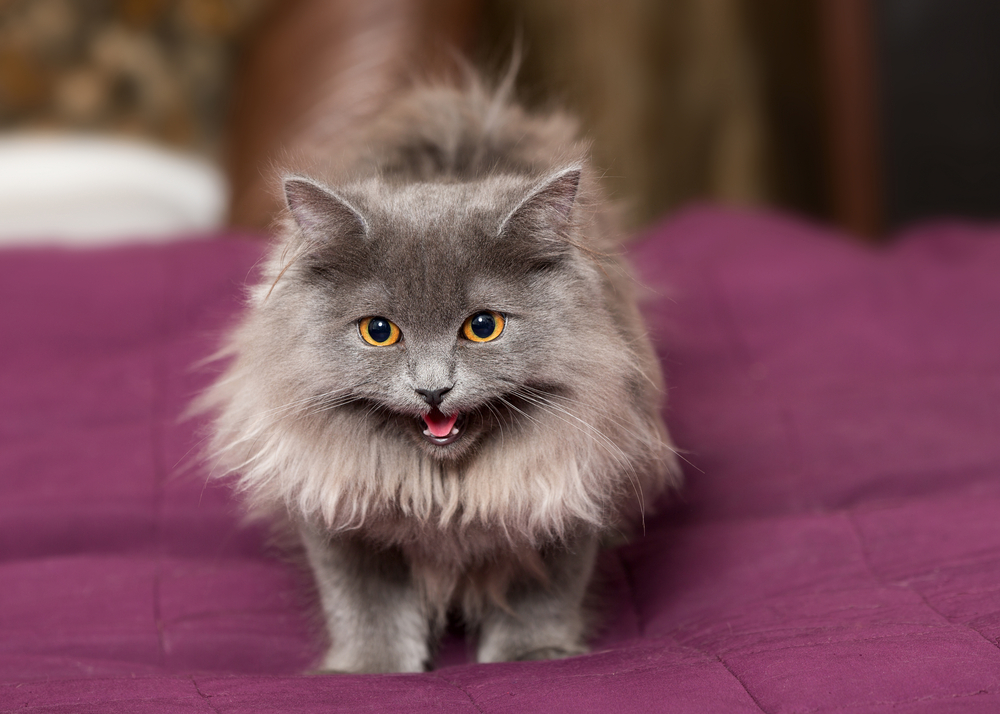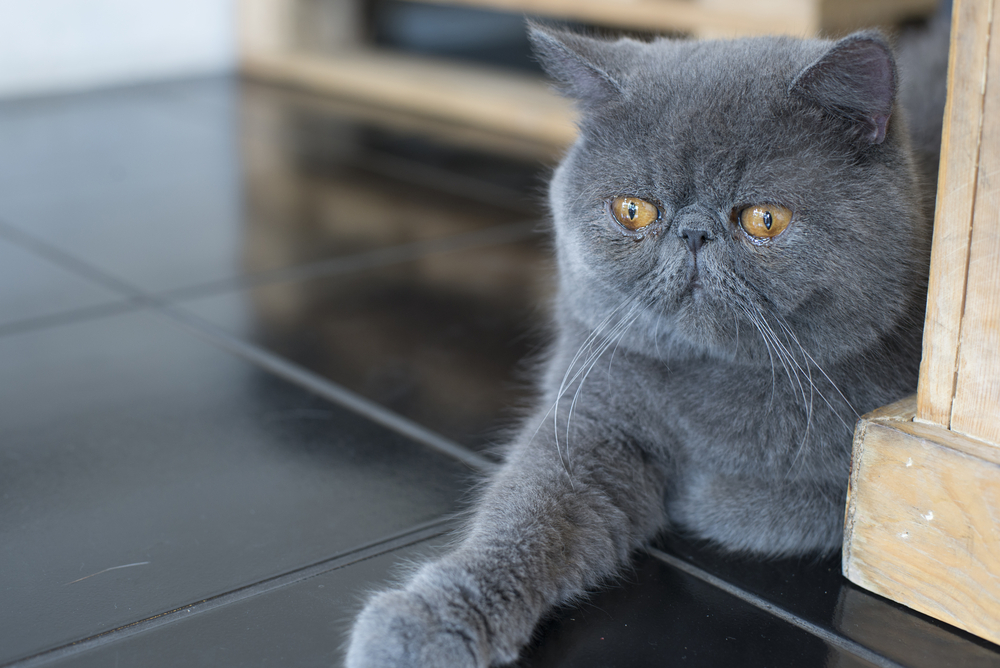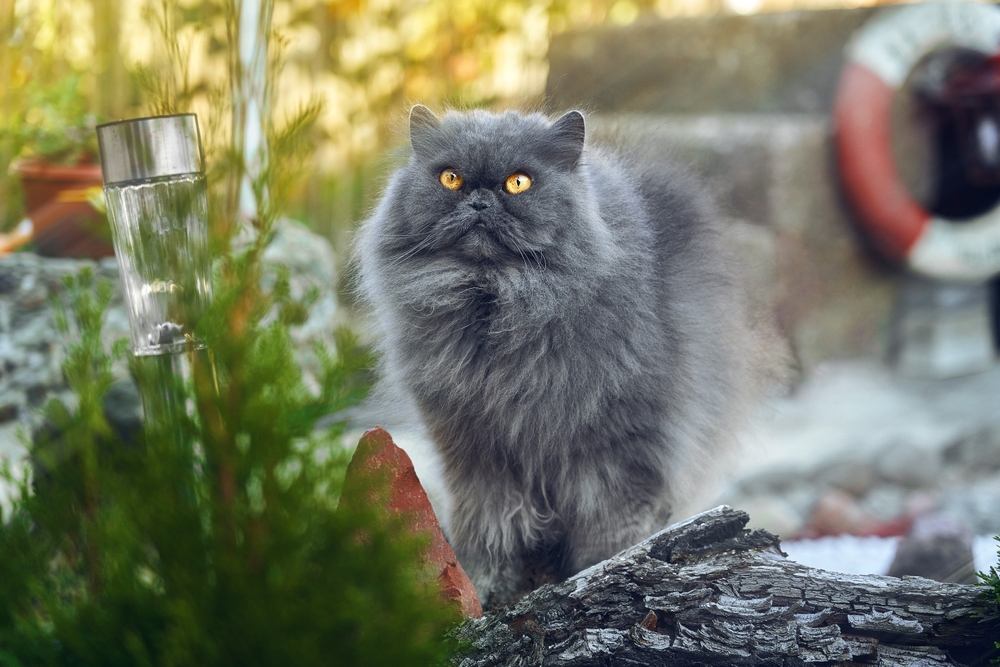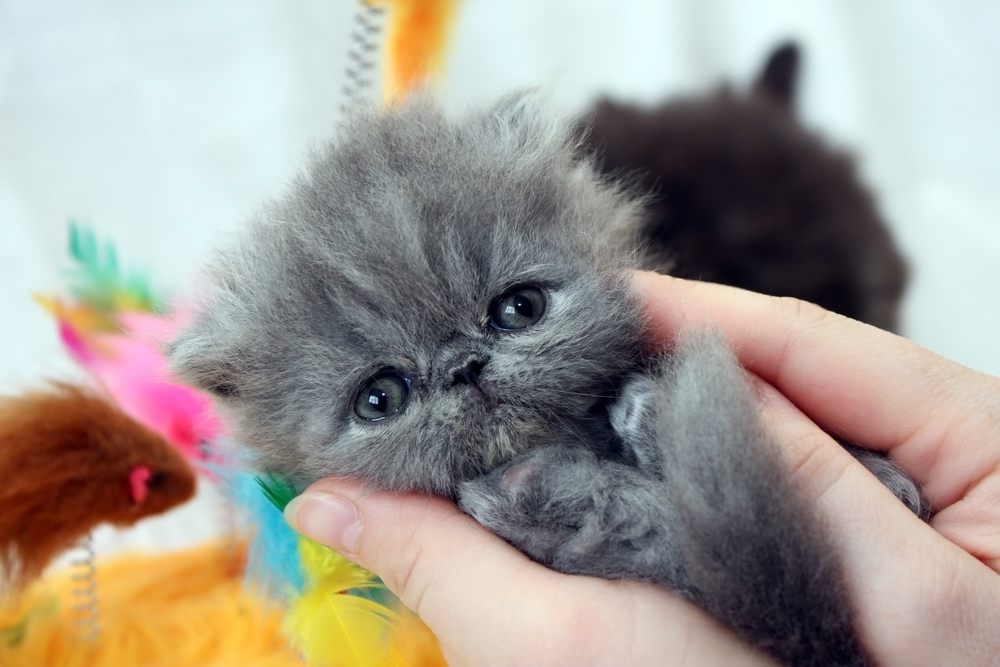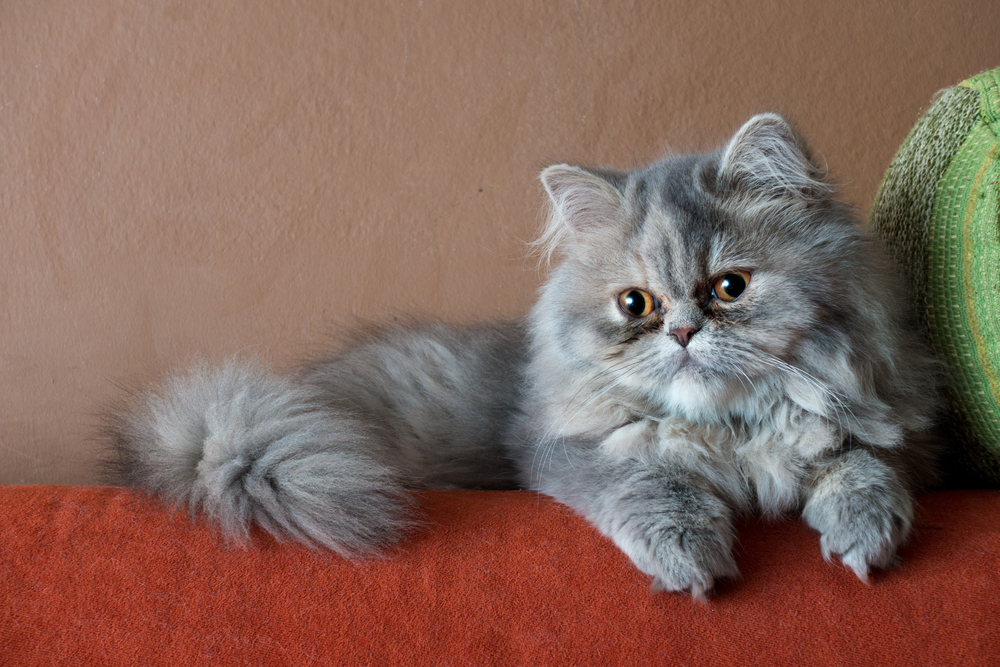📖 Table of Content:
Persian cats are the most popular pedigree cat breed in the U.S. With flowy, fluffy fur, round, robust heads, and flat faces that resemble Pekingese puppies, Persian cats are a sight for sore eyes. We’d argue that Persian cats are everyone’s cup of tea, but blue Persian cats take the cake.
Blue Persian cats are one of the most sought-after flat-faced felines out there. But before you wonder whether they’re actually blue, they’re not. They’re nicknamed “blue longhairs” because of their lustrous, luxurious coats that take on a bluish-gray, silver, or slate color.
Persian cats attract attention everywhere they go, but there’s something to be noted about certain colors and color combinations that seem to rub pet parents the right way. Persian coats come in different colors, the most common of which are white, black, blue, gray, orange, silver, golden, lilac, cream, and brown.
Patterns make a world of difference, too, and the most common Persian patterns are tabby, tortie, calico, bi-colored, and solid-colored. Blue Persian cats are solid-colored, but these fashionable felines are “solid” in more ways than one. Before you decide to bless your life with a blue Persian cat, read more down below.
What are blue Persian cats?
We’re pretty sure everyone knows what Persian cats look like. With smooshed mouths and snouts that resemble a garden pansy, Persians are one of the most accepted and adored cat breeds around the world. Add to that an affectionate, addicting purrsonality, and you get a purrfect pet.
What are blue Persian cats? We know that Persians come with cute coats that can be black, white, blue, brown, or a myriad of color combinations you’ve never seen before. Blue Persian cats are mysterious meowers that appear blue but are actually black – blue is the diluted version of black in the pet world.
Blue Persian cats can appear gray, silver, or slate, depending on the gene that’s responsible for the color of the cat’s coat. But whatever the case might be, blue Persian cats are one of the most beautiful, bold breeds you’re ever going to meet – and they’re more than deserving of getting spoiled rotten.
What’s the history of blue Persian cats?
Let’s start at the beginning, shall we? We don’t know whether the first Persian cats were blue, black, or a completely different color combination, but we do know that written documents and records trace them back to the 1500s.
Before we even knew what Persian cats looked like, people uncovered traces of luscious, long-haired cats on ancient hieroglyphs. But most people agree that Persians appeared around the 1600s when a bunch of long-haired cats were smuggled from Persia to Europe.
By the 1800s, Persian cats became symbols of opulence. When they reached Britain, Queen Victoria became enamored with them and contributed to the breed’s status of elegance, sophistication, and nobility. Persians took the world by storm and became popular with figures like Florence Nightingale.
They became the OG show kitties, too. When the first cat show ever took place in London’s Crystal Palace in 1871, Persians became one of the earliest pedigreed felines to compete. Needless to say, when the first cat fancier associations started with work, Persian cats were accepted as purebred by them, too.
What to expect when you get a blue Persian cat
Physical traits of the blue Persian
Blue Persian cats are no different from black or white Persian cats – there’s no mistaking a Persian cat when you see one. Persians are chubby, stubby, and short, and they’re defined by sturdy, muscular legs, round, robust heads, and thick necks.
Contrary to what you might think, Persian cats aren’t big. They’re considered medium, with an average weight of 8 to 14 pounds and measurements of 10 to 15 inches tall and 15 to 18 inches long.
The coats are what most Persian cat connoisseurs go on and on about, though – and for a good reason, too. Persians come with long, lustrous coats that consist of two layers – a short undercoat and a long topcoat.
They can sport a number of different color combinations, but blue Persian cats are gray, silver, or slate. Blue Persian cats are prone to shedding, matting, and tangling, and they’re the opposite of a hypoallergenic cat.
When you get a Persian kitty, know that you’ll be spending hours and hours combing and brushing her fur to ensure you’re getting rid of mats and tangles. You’re probably going to spend even more time bathing her whenever her fur gets greasy or stringy.
Persian cats are worth your effort and energy, though. They’re simply the sweetest flat-faced felines out there.
Personality traits of the blue Persian
Persians’ physical features are the first thing that comes to mind when talking about blue Persian cats, but these curious creatures aren’t all looks. Persian cats are affectionate and appreciative, and they’re known to make for purrfect pets because they’re loyal, lovable, and completely chill.
With a Persian kitty, you don’t need to worry about your furniture getting destroyed or your home decor getting knocked down. They prefer to nap, nibble on delicious treats, and snuggle the day away.
If they get to sit on a window perch chirruping at birds or roll on the floor, looking for the purrfect spot to nap, they’re happy. Persians aren’t big on running around the apartment, spending time outside, or climbing on cat trees.
They’re much more comfortable with soft sofas, comfy cushions, and Netflix.
We don’t know what your preferences are, but Persian cats are made to be lap cats, and that’s why they’re fitting for pet parents who aren’t that active. Persian cats may not be the strongest or most intelligent breed, but they’re guaranteed to make your everyday existence better.
5 fun facts about blue Persian cats
1. Blue Persian cats aren’t actually blue
We might as well address the elephant in the room and say that blue Persian cats aren’t actually blue. We know that might be confusing to people who are trying to get to know blue Persian cats better, but that’s the case with pets – they’re never gray or silver, they’re almost always referred to as blue.
Blue Persian cats are gray, silver, or slate, but they’re known to appear blue under certain lights. In the animal world, blue happens to be a dilute version of black. Blue Persian cats are born “blue” because of the dilute gene. This gene is responsible for the intensity of the coat color by affecting the amount of pigments in the hair shaft.
When the dilute gene is present, the pigment granules are clumped together along the hair shaft, causing the color of the coat to be clear. When mixed with the existing pigment, the end result is a diluted version of whatever color the cat was supposed to be.
2. Persians are couch potatoes
Siamese, Bengals, and even Maine Coons are described as “dogs of the cat world” because they’re energetic, fun, and friendly. More times than not, these three breeds are excited to walk on a leash, play fetch, learn tricks, and go for walks outside.
Persian cats are the exact opposite of that. They’re couch potatoes that tend to stay close to the ground and monitor everything that’s going on around them. Persian cats appreciate attention and affection, but they’re content to hang out with you or by themselves.
3. Not all blue Persian cats have a flat face
We can’t forget that there are two types of Persian cats. When Persian cats appeared for the first time, these curious creatures didn’t have the flat faces we know and adore nowadays.
“Traditional” Persian cats were much more simple and sleek, and they were defined by their fluffy, flowy fur rather than anything else.
“Show” Persian cats appeared afterward when breeders started to select specific traits that scored better on cat shows. Soon, Persian cats with smooshed mouths and noses, smaller ears, rounder heads, and fluffier fur appeared on the scene.
Whether your kitty is a Peke-face or a doll-face, know that both share the same sweet demeanor and gentle nature.
4. Persians aren’t the sharpest tools in the shed
We know that sounds mean, but bear with us. What we mean when we argue that Persian cats aren’t the brightest of the bunch is that these bundles of cuddles aren’t cunning, crafty, or mischievous.
They aren’t adamant about getting in trouble. They’re way too busy trying to see how many hours they can spend on the sofa before having to get up to use the litter box. We’re sure there’s nothing your Persian purrincess can’t do, but the problem is that she might not want to do anything.
5. Blue Persian cats are bad at grooming
Persians, blue or otherwise, are bad at grooming. Most cats resort to chewing, biting, and pawing to get rid of mats and tangles, but these meowers are unable to do that because they’re “blessed” with flat faces that prevent them from getting in there.
Moreover, Persian cats are double-coated and are unable to reach the undercoat when trying to groom themselves. Worry not, though. With a regular grooming routine, you can keep your Persian cat happy and healthy.
